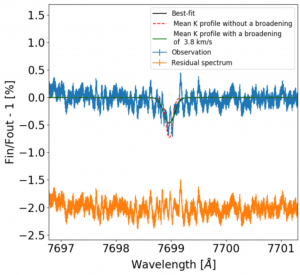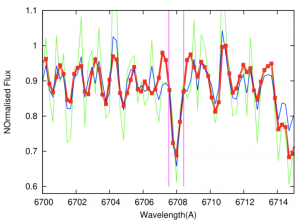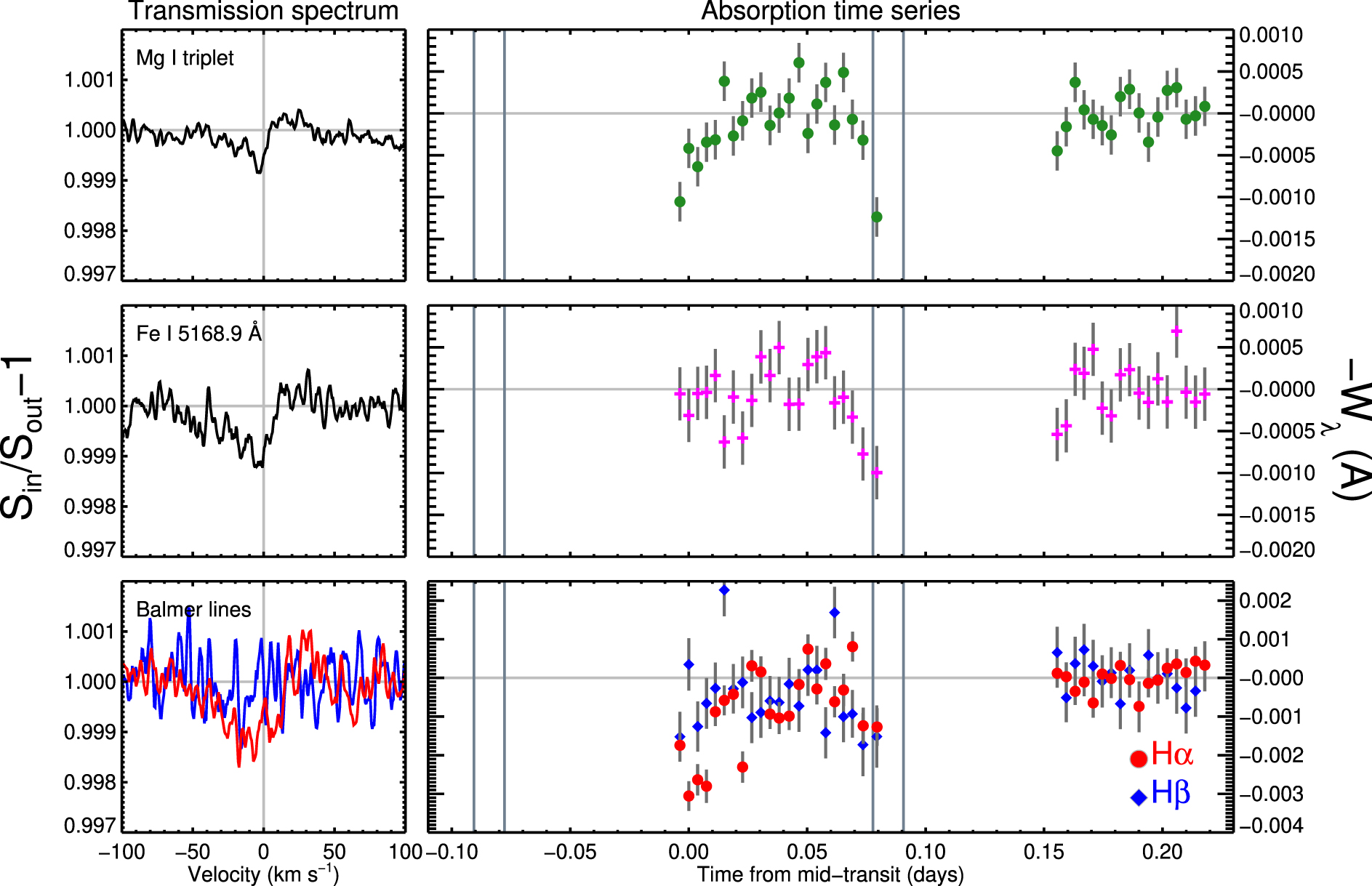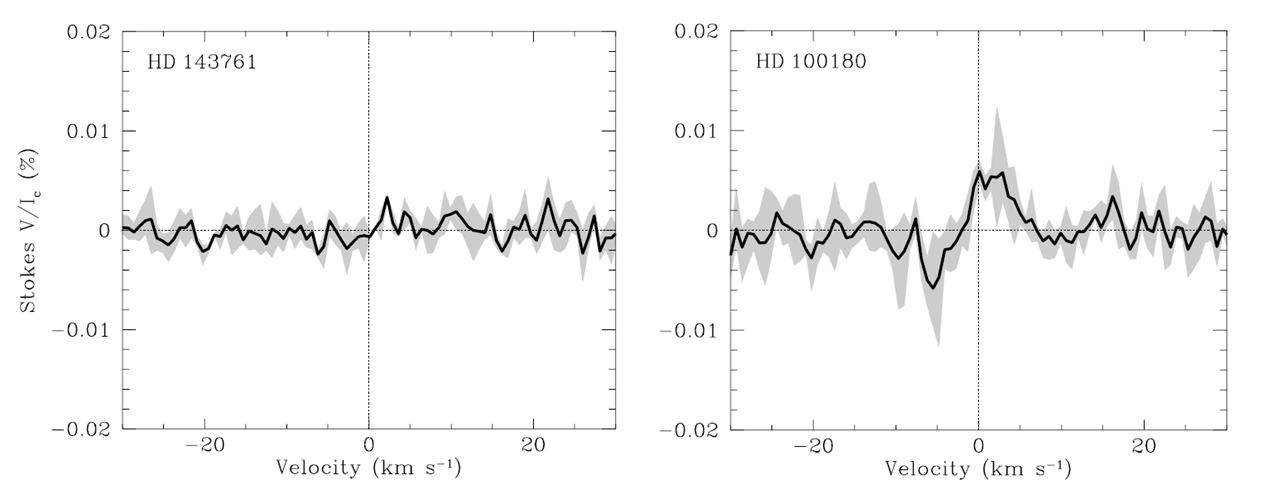
Probing the atmosphere of HD 189733b with the Na I and K I spectral lines



We observed a partial transit of the ultra-hot Jupiter WASP-189 b with PEPSI on the LBT. We detect a highly variable transit signal in multiple atomic transitions, including H-alpha, Fe I, and Mg I. The signal is not consistent with a transiting planetary atmosphere. We suggest instead that the in-transit signal is due to an inhomogeneous stellar surface. Our observations demonstrate the lack of a highly extended atmosphere in common optical atomic tracers. Although WASP-189 is very bright, atmospheric characterization of the planet will be difficult due to the small transit depth and apparently compact atmosphere.

Read more: Wilson et al. 2020, Research Notes of the AAS, Volume 4, Issue 4, id.53
January 2019 featured a total lunar eclipse. The Moon dimmed by a factor of 20,000 (10.75 mag) during totality. Therefore, the light gathering capability of the 11.8 m Large Binocular Telescope (LBT) in Arizona was needed for the observations. Additionally, the high spectral resolution of the Potsdam Echelle Polarimetric and Spectroscopic Instrument (PEPSI) was necessary to separate the expected tiny spectral-line absorptions of the Earth’s atmosphere from the normal solar spectrum at unprecedented spectral resolution and in polarized light. The radial velocities trace a wavelength dependent Rossiter-McLaughlin effect of the Earth eclipsing the Sun as seen from the Tycho crater confirming earlier observations. No line polarization of any spectral-line feature is detected outside nor inside eclipse. This places an upper limit of ≈0.2% on the degree of line polarization during transmission through Earth’s atmosphere and magnetosphere.
Read more: Strassmeier et al., 2020, A&A, 635, 156
Synoptic Sun-as-a-star observations are carried out with the Potsdam Echelle Polarimetric and Spectroscopic Instrument (PEPSI), which receives light from the Solar Disk-Integration (SDI) telescope. Daily spectra are produced with a high signal-to-noise ratio, providing access to unprecedented quasi-continuous, long-term, disk-integrated spectra of the Sun with high spectral and temporal resolution. We developed tools to monitor and study solar activity on different time-scales ranging from daily changes, over periods related to solar rotation, to annual and decadal trends. Strong chromospheric absorption lines, such as the Ca II H & K λ3934 & 3968 Å lines, are powerful diagnostic tools for solar activity studies, since they trace the variations of the solar magnetic field. Other lines, such as Hα λ6563 Å line and the near-infrared (NIR) Ca II λ8542 Å line, provide additional information on the physical properties in this highly complex and dynamic atmospheric layer. Currently, we work on a data pipeline for extraction, calibration, and analysis of the PEPSI/SDI data. We compare the SDI data with daily spectra from the Integrated Sunlight Spectrometer (ISS), which is part of the Synoptic Long-Term Investigation of the Sun (SOLIS) facility operated by the U.S. National Solar Observatory (NSO). This facilitates cross-calibration and validation of the SDI data.
Download PDF.
LBT/PEPSI spectropolarimetry tested the hypothesis that the surface magnetic morphology is a crucial component for the spin down of stars. Solar-type stars are born with relatively rapid rotation and strong magnetic fields. Through a process known as magnetic braking, the rotation slows over time as stellar winds gradually remove angular momentum from the system. The rate of angular momentum loss depends sensitively on the magnetic morphology, with the dipole field exerting the largest torque on the star. One hypothesis to explain this reduction in efficiency is a shift in magnetic morphology from predominantly larger to smaller spatial scales. We tested this hypothesis with spectropolarimetric measurements of two stars that sample chromospheric activity levels on opposite sides of the proposed magnetic transition. As predicted, the more active star (HD 100180) exhibits a significant circular polarization signature due to a non-axisymmetric large-scale magnetic field, while the less active star (HD 143761) shows no significant signal.

Read more: Metcalfe et al. 2019, ApJ Letters, 887, 38
We investigated the potassium excess absorption around 7699 Å of the exoplanets HD189733b and HD209458b using high-spectral resolution transit observations acquired with the 2 × 8.4 m Large Binocular Telescope (LBT) and the Potsdam Echelle Polarimetric and Spectroscopic Instrument (PEPSI). For a bandwidth of 0.8 Å, we present a detection >7σ with an absorption level of 0.18 per cent for HD189733b. Applying the same analysis to HD209458b, we can set 3σ upper limit of 0.09 per cent, even though a K-excess absorption was not detected. The investigation suggests that the K feature is less present in the atmosphere of HD209458b than in the one of HD189733b and confirms previous claims that the atmospheres of these two planets must have fundamentally different properties.

Read more: Keles et al. 2019, MNRAS, 489, L37
The Potsdam Echelle Polarimetric and Spectroscopic Instrument (PEPSI) is a state-of-the-art, thermally stabilized, fiber-fed, high-resolution spectrograph for the Large Binocular Telescope (LBT) at Mt. Graham, Arizona. During daytime the instrument is fed with sunlight from the 10-millimeter aperture, fully automated, binocular Solar Disk-Integrated (SDI) telescope. The observed Sun-as-a-star spectra contain a multitude of photospheric and chromospheric spectral lines in the wavelength ranges 4200-4800 Å and 5300-6300 Å. One of the advantages of PEPSI is that solar spectra are recorded in the exactly same manner as nighttime targets. Thus, solar and stellar spectra can be directly compared. PEPSI/SDI recorded 116 Sun-as-a-star spectra during the 2017 August 21 solar eclipse. The observed maximum obscuration was 61.6%. The spectra were taken with a spectral resolution of ≈ 250000 and an exposure time of 0.3 s. The high-spectral resolution facilitates detecting subtle changes in the spectra while the Moon passes the solar disk. Sun-as-a-star spectra are affected by changing contributions due to limb darkening and solar differential rotation, and to a lesser extend by supergranular velocity pattern and the presence of active regions on the solar surface. The goal of this study is to investigate the temporal evolution of the chromospheric Na D doublet during the eclipse and to compare observations with synthetic line profiles computed with the state-of-the-art Bifrost code.
Read more: Dineva et al. 2020, IAU Symp. 354, 473
Download PDF.
We present a time series of 13 consecutive Doppler images covering six months in 2017 that we used to measure the surface differential rotation with a cross-correlation method. Hitherto unpublished high-precision photometric data from 1989 to 2017 are presented. We applied Fourier-transformation-based frequency analysis to both photometry and spectra. Very high resolution (R ≈ 200 000) spectra were used to update IN Com’s astrophysical parameters by means of spectral synthesis.
Results: Our time-series Doppler images show cool and warm spots coexisting with an average surface temperature contrast of -1000 K and +300 K with respect to the effective temperature. Approximately 8% of the stellar surface is covered with cool spots and ∼3% with warm spots. A consistent cool polar spot is seen in all images. The average lifetime of the cool spots is not much more than a few stellar rotations (one month), while the warm spots appear to live longer (three months) and are mostly confined to high latitudes. We found anti-solar surface differential rotation with a shear coefficient of α = -0.026 ± 0.005 suggesting an equatorial rotation period of 5.973 ± 0.008 d. We reconfirm the 5.9 day rotation period of the cool star from photometry, radial velocities, and Hα line-profile variations. A long-term V-brightness variation with a likely period of 7.2 yr is also found. It appears in phase with the orbital radial velocity of the binary system in the sense that it is brightest at highest velocity and faintest at lowest velocity, that is, at the two phases of quadrature. We redetermine [Ba/Fe], [Y/Fe], and [Sr/Fe] ratios and confirm the overabundance of these s-process elements in the atmosphere of IN Com.

Read more: Kovari et al. 2019, A&A 624, A83
We present a temperature and a magnetic-field surface map of the K2 subgiant of the active binary II Peg. Employed are high resolution Stokes IV spectra obtained with the new Potsdam Echelle Polarimetric and Spectroscopic Instrument (PEPSI) at the Large Binocular Telescope (LBT). Our main result is that the temperature features on II Peg closely correlate with its magnetic field topology. We find a warm spot (350K warmer with respect to the effective temperature) of positive polarity and radial field density of 1.1 kG coexisting with a cool spot (780K cooler) of negative polarity of 2 kG.


Read more: Strassmeier, Carroll & Ilyin 2019 A&A, 625, 27
AIP press release
LBT press release